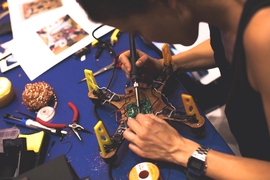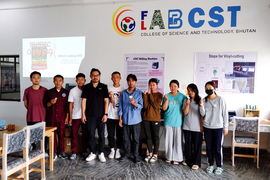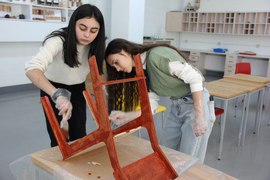What do a student tinkerer in Bhutan, a design professional in Nairobi, and an artist in Brazil have in common? They’re part of a global community of makers benefiting from the fab lab network, which provides the space, equipment, and training to make (almost) anything.
Today the fab lab network includes more than 2,500 centers across 125 countries, including places as remote as northern Norway and as populated as the city centers of Cairo and Barcelona. Each lab provides community access to equipment such as laser cutters, computer-controlled milling machines, and 3D printers, along with training to use the equipment.
Some fab labs emphasize themes like sustainability or bridging community divides, while others focus on strengthening the local workforce or empowering students to become activists. But the similarities between fab labs may strike visitors more than the differences. And although advanced fabrication equipment is the labs’ most visible feature, people most often talk about the common energy they feel when surrounded by creators pursuing their passions.
MIT Professor Neil Gershenfeld, who is also director of MIT’s Center for Bits and Atoms (CBA), created the first fab lab with the late Mel King, a legendary civil rights activist and former MIT adjunct professor who saw the fab lab’s potential to empower communities. From there, the expansion into a wider network was driven by grassroots interest from far-flung communities around the globe.
Fab Lab becomes Fab Network
Gershenfeld and his colleagues launched CBA in 2001 to study the boundary between computer science and physical science, and with National Science Foundation (NSF) support they created a digital fabrication research facility with equipment to make objects of any size, from the scale of atoms to buildings. But it would take a lifetime of existing courses at MIT to learn to use all of the machines, so they began teaching a new course, MAS.863 (How To Make (almost) Anything). The course has been one of the most popular at MIT since its inception.
Inspired by that response, in 2003 Gershenfeld met with King to explore an outreach project for the NSF. Following his retirement from MIT, King, who passed away in March, had created the South End Technology Center (SETC) to expand access to technology in Boston communities, and he saw the lab as a powerful way to further that mission.
“Neil said, ‘Hey Mel, you should bring your kids over to my lab,’ and Mel said, ‘You should bring your lab over to my kids,’” says Megan Smith ’86, SM ’88, former White House chief technology officer and a member of the MIT Corporation, who has visited fab labs around the country.
King became a mentor for Gershenfeld. “We went to see Mel, and he instantly leapt from providing access to technology to the means to create technology,” Gershenfeld recalls, noting that King had also pioneered community television, community computing, and community Internet. “It was the obvious next step in the evolution for him. We didn’t have to convince him of anything or explain how it fit.”
Gershenfeld and his colleagues worked with King to create at SETC a community-scale version of their lab at MIT, offering equipment, software, and training. It was an instant success.
“What really drove the success of the SETC lab — and all the fab labs — is the passion to create,” Gershenfeld says. “There’s a passion to make from bright, inventive people, who often are refugees from very rigid schools or companies who are attracted. They get pulled in for the capabilities but stay for the culture.”
As SETC’s fab lab took off, the Ghanaian community in Boston surprised Gershenfeld’s team by asking them to help make one in Ghana. After that, a contingent from South Africa wanted one. Then northern Norway. Then rural India.
“We did about 10 fab labs where we’d open one and then someone else would want one,” Gershenfeld says. “Once we got up to about 10 we saw it was beginning to scale globally. Later we noticed the number of fab labs was doubling roughly every two years, just like Moore’s Law for chips, and we realized something much larger was happening.”
In 2009, members of the fab lab network started the nonprofit Fab Foundation to facilitate the growth of more labs. Its leaders still credit King for helping them see the potential for expansion. “Mel’s tech center was bringing kids into this world where they could be productive, build wealth, and be seen as the innovative spirits that they are,” says Fab Foundation CEO Sherry Lassiter, who has worked with Gershenfeld since 2001. “He taught us how you bring communities together.”
Fab Network goes global
As the fab lab network has expanded, it has systematized its support programs. The classes and training the labs offer has blossomed into the Fab Academy, a hands-on global version of the MIT class. Meetings among fab lab organizers grew into the Fab Summit, an annual event that brings makers together to share learnings and best practices. MIT last hosted the summit in 2015. This year’s event is in Bhutan, then it will return to MIT in 2026 after going to Mexico and the Czech Republic.
“In one sense, it’s the most diverse event I know of: You have people from every ethnicity, every income level, etc.,” Gershenfeld says. “But in another sense, it’s similar people in all of those different packages: bright, inventive change agents.”
At a Fab Summit in Barcelona in 2013, the mayor made the bold commitment for the city to produce everything it consumes within 40 years. That commitment sparked the Fab City Initiative, through which similar commitments have been made by 49 cities and regions, including Boston, Cambridge, and Somerville.
The initiative is an example of the high aspirations of the fab lab network, which seeks not just to support makers but to change the way societies make.
“Our systems of production and consumption are incrementally producing social conflicts and environmental devastation, but what if we can create a shortcut by bringing production back to the city?” asks Tomas Diez, the executive director of the Fab City Initiative who helped set up the first fab lab in Barcelona. “It won’t happen in one day. We have to work within the current system to transform it. But it’s going to create new business opportunities and a new economy based on a reorganization of our resources.”
Accelerating potential
Inclusivity is another common thread among Fab Labs. In fact, many people compare fab labs to libraries because they are available to be used to create whatever individuals decide.
There are countless stories of fab labs changing people’s direction in life. One such person is Jens Dyvik, who did an internship at a fab lab in Amsterdam that inspired him to spend two years touring fab labs around the world, staying for two or three weeks at each lab and volunteering in any ways he could. When Dyvik returned, he started a fab lab in Olso, Norway.
“I got super interested in open hardware and in the potential of what Neil describes as distributing ideas globally and fabricating locally,” Dyvik says. “I wanted to see if I could contribute to make that reality.”
Gershenfeld says that fab labs are now transitioning from providing access to tools to making the tools themselves. To help facilitate that transition, CBA is helping communities create what he calls super fab labs with more advanced capabilities that can make the components that go into those machines. The first of these was in the south of India, in Kerala, followed by one in Bhutan.
“Some people have basically locally cloned elements of our fab lab,” Dyvik says. “We helped them with training, and it wasn’t so much the money that was saved as the learning along the way.”
Gershenfeld believes machines making machines is the next step for improving access to the means of production. He says King had a lot to do with that idea. “The step after fab labs is you don’t buy the tool and then go to the fab lab to use it, you go to the fab lab to make it, so that the tools themselves can spread democratically and virally,” Gershenfeld says. “Technology was Mel’s focus later in life. He grabbed onto this idea of not just making something, but making something with the means to make itself.”
Back at CBA, researchers are working on realizing King’s vision with assemblers and then self-assemblers, coming attractions for the future of fab labs. But the spread of fab labs shows that it’s not necessary to wait on those results to transform society today.
















